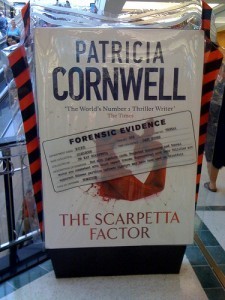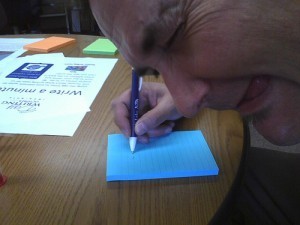Melanie Edmonds's Blog, page 34
February 13, 2013
Independent vs Traditional Publishing: Marketing

You could have your book wrapped entirely in plastic, too!
Photo by TheCreativePenn
(Part of the indie vs trad series.)
When you publish a book, you have to tell people about it. Otherwise, how do they know it exists? That’s what marketing is for: getting the word out so people come and buy your stuff.
This one is slippery to consider in the indie vs traditional publishing debate, because there are so many possible mitigating factors. To make it simpler to assess, let’s assume that you haven’t had a bestseller yet (that tends to change all the rules). Let’s assume that you’re starting out, or you’ve got a few books out but none of them have ‘taken off’ in a big way yet. That way, we’re looking at a level playing field (and let’s face it, if you’ve got a bestseller and ‘made it’, you’ve probably already gone through this process and have an approach that works for you).
With self-publishing, it’s all up to you. You can hire someone to help you out, but that’s all on you as the author. There’s no-one that’s going to do that for you, and in many ways, you get out what you put in.
It is easy to assume that a traditional publisher will solve the marketing problem for you. Because these companies have resources and experience – and are, after all, in the business of selling books – it’s a safe assumption that they’ll do everything they can to sell your book. Right?
Every published author I’ve talked to says different. Yes, the publisher will spend some money to promote you, and of course they’ll want your book to be a success. They’ll design the cover, posters, adverts, and maybe a book trailer for you. They might even place some adverts in publications about your book.
But their willingness to go beyond that is variable and often non-existent. The likelihood of a publishing house to pay for you to go to book signings or conventions is dictated very much by the bottom line; most authors, particularly mid-list and those starting out, foot their own bills. It’s up to the author to travel around to the bookstores and do signings, to book themselves into conventions and conferences, and to sell their books to anyone who comes within shouting distance. Often, authors wind up creating their own promotional merchandise as well (pens, bookmarks, etc), which means paying for it to be made so they have stock on hand to give away.
Then there are the more ethereal aspects of book marketing. Building your author brand; connecting with your audience; getting involved in communities: all of these things take time and effort, and it doesn’t matter which way you get published. A traditional publisher isn’t going to do that for you. It’s a lot of time and, sometimes, money. From talking to traditionally- and self-published authors, the effort required seems to be about the same.
(If you want an idea about the kinds of things I’m talking about here, check out Mark Coker’s free ebook on this subject: Smashwords Book Marketing Guide.)
Whichever publishing route you go down, it’s a lot of work. It’s pounding pavement and pressing flesh. It’s creating an author brand and platform. It’s getting your presence ‘out there’. And it’s all down to you.
Going independent means paying all of your bills. It means designing your own marketing materials and campaign, and managing it from start to finish (or hiring someone to do it for you). You answer only to yourself, and there’s no-one to blame but yourself. With traditional publishing, you’ll get some cool posters and marketing materials to play with, the base collateral which should be targeted to your specific audience, but not a great deal beyond that.
It’s worth keeping the relative importance of marketing in mind, too. All of the advice I’ve seen on this subject says that the number one factor in sales is writing a good book. Second is word of mouth (which is dependent on the first). You can’t buy either of those things.
The real questions: do you have the marketing knowledge and experience to manage it yourself? How much money can you afford (or are willing to) put in? What is the best way to reach your audience? Do you know? What kind of weight are you willing to place on marketing?
I’m terrible at self-marketing and I freely admit that. It’s something I try to work on every day. It is definitely a lot of work, but here’s hoping that it’s worth it!
Next up: Services
February 7, 2013
The writing challenge challenge

Yes, this is me right now. Only I’m prettier.
This will be all of you when I get this going.
Photo of/by Clint Gardner.
Is that a mistake in the title? No, it’s not.
A little while ago, I posted about an idea I had for a day of writing challenges. It’s going to be in April, because that’s the month when I can’t hold my regular Creative Writing Group meeting. It got an awesome response! People are enthused! Yay!
I realised yesterday that shit, it’s February already. I have about 2 months to sort it all out.
Ahhh.
So much to sort out. I really need to get myself into gear and get it moving. Contact the QWC. Sort out a venue. And, mostly importantly, work out the challenges I’m going to be running.
What’s a suitable writing challenge? Hmm. I have a few ideas that are percolating, and I have started making notes and plans. I’m putting them someplace secret, so no-one peeks ahead of time. I’m thinking that I’ll need 6 in total: one per hour, from 11am until 4pm (running until 5pm to finish the last challenge).
6. That’s both a lot and not many at all. I want a variety, lots of different kinds of areas and methods. I want everyone to be able to try something they’ve never done before (or tend to avoid). I want them to be hard (like a challenge should be!). I want them to be stretching. Yeah, I want everything, in a single day, with lols and laughs to boot.
So that’s my personal challenge at the moment: finding or creating 6 different challenges. I’ve got a few in mind. Let’s see how long it takes to refine them into a challenge that writers will relish.
Oh, and the event now has a name: Writer’s Asylum. Ahahahaha.
February 6, 2013
Independent vs Traditional Publishing: Distribution

This is probably not the most effective distribution method for your books.
Picture by Corey Leopold.
(Part of the indie vs trad series.)
The purpose of publishing your work is to reach an audience and have the best sales you can. That means you’ve got to get your published book out to as many people as possible, so it needs to get to as many stores as possible. For this, you need access to a distribution network.
This is the area where traditional publishing have traditionally held the high ground. The biggest advantage they have is their distribution network and marketplace presence. They will send your book to all corners of the region (whatever geographical region you have signed with them to be published in), and it will appear on bookshelves in front of bookstore browsers everywhere. Traditional publishers are in the business of selling books and getting them out to the customer is exactly something they’re set up to do.
For a self-publishing author, it is difficult to match this when it comes to paper books. It requires a lot of money, contacts, deals, and effort.
However, if you’ve been reading any of the publishing-related blogs or news out there, you’ll know that ebooks are on the rise in a big way. Predictions state that they’ll outstrip paper books in the next year or so, in sales volume if not in monetary worth (due to the disparity between paper and ebook prices).
So what about distribution of ebooks? How easy is that to achieve?
In the ebook realm, traditional publishers’ reach doesn’t outstrip the indie authors’ options. More and more retailers are adding self-publishing options to their services, allowing independent authors to publish directly to their store: over the last year, Barnes & Noble and Apple added their names to the list of venues for this, and Amazon’s KDP service has been going for some time now.
Even better, indie authors can use ebook distributors to reach even more stores. Smashwords is the biggest of these, and distributes books to retailers and libraries beyond what an author can reach alone. Check out Mark Coker’s The Secrets to Ebook Publishing Success for more information on the advantages of self-published authors using a distributor.
Having publishing ebooks myself, I can attest that it’s very simple for authors to do themselves.
The real questions: what format do you want to be published in? How important is the format to you? Do you want to see your book on a real bookshelf or a virtual one? Where do you think your audience lives most?
As far as reaching readers and getting your book ‘out there’ goes, traditional publishers win hands-down for paper books, but the war is still raging in the electronic space. I’d say that the stakes are probably even there right now for sheer distribution power.
Next up: Marketing
February 5, 2013
Mountain high

The view from on high.
Photo by the lovely Jess.
I have been doing a lot of writing-centric posts lately (yay!). Here’s one about the semi-writing-related stuff I’ve been up to lately, just to mix things up and because I’m struggling to get another advice piece up at the moment.
Last week, I had a break from work. It was a good chance to decompress and take things easy, even though my to-do list was daunting. In the end, I didn’t get to most of my to-do list, but seeing as the week was intended to be a rest for me, I don’t feel bad about that.
I got the important stuff done. Like taking a drive up a mountain with my lovely NaNoWriMo co-MLs, to check out a conference centre and resort for this year’s Writer’s Retreat.
Of course, Queensland weather being what it is, we were hammered by storms early last week: there were trees down and landslips everywhere, and going up a mountain is a tricky endeavour at the best of times. Luckily, Queenslanders being who they are, by the end of the week most of the damage had been cleared away, and even my poor little car managed to make the trip up to the top (~1,000ft above sea level).
It is gorgeous up there. It’s a subtropical rainforest at that altitude, so as you go up, you pass through fields and woodlands, and then into dark avenues through the forest. Exposed rockfaces, dangerous inclines and landslip areas, ferns and palm trees. Sudden vistas of trees rippled into valleys and stretches of green to more mountains, hazy in the distance. The talk of dinosaurs was only natural in that setting (I suspect at least one of us went home and watched Jurassic Park afterwards!).
(Also, you know you’ve been playing too much Guild Wars 2 when you see a beautiful view and start wondering where the jumping puzzle to the vista is.)
We got to see so much of the mountaintop once we got up there. The lovely conference manager at the resort showed us around, which involved climbing in and out of a 4×4 to navigate the tracks and ‘roads’ (I use the term loosely). He showed us everything up there, from a little out-of-the-way BBQ shack with a dirt floor, to a precipice leaning over a sprawling view, to cows (they farm up there, wtf), to the flying fox, to the conference centre and villas.
In the resort and centre, we got to see inside all the rooms and villas, and looked at all the options available to us when we put our retreat package together. It’s lovely. I wasn’t the only one to fall in love with it all, and I can totally picture us there for a weekend, clutching our laptops, typing furiously… and taking breaks in the infinity pool that spills down towards the edge of a cliff. Plus there’s a spa in the conference centre, and a good massage never goes amiss for poor, overworked MLs.
What’s the downside, I hear you ask? Because we all know there has to be one. Well, it’s more expensive than last year’s venue. I know that’s going to impact some of our attendees pretty significantly. We’re looking at the options available to see where we can slide in some savings, as well as alternate venues, but it’s still going to come out more expensive. This is part of why we’re starting work on this so early, so we can let everyone know and they can start saving. But it’s going to be so worth it.
It’s also not the easiest place to get to. However, we have a couple of things in mind to mitigate that, like coach options. I’m sure we can work something out. (If we can get 35 people to an island and back, I’m sure we can get ‘em up a mountain.)
Overall, while we still have a lot of planning to do, I’m feeling really good about the Retreat this year. It’s going to be even better than last year. Can’t wait to get moving on it!
January 30, 2013
Independent vs Traditional Publishing: Creative Control
(Part of the indie vs trad series.)
Control over your work is a big issue for many creators, including me. I’m not shy about being a bit of a control-freak and relinquishing grip on your creative baby is hard for most writers. When it comes to publishing, the control that you retain as an author varies depending on which way you go with it.
Creative control includes having the final say in many aspects of your project. Let’s break it down a bit.
Copyrights
The rights relating to your work include:
Translation
Audio
Movie
Merchandise
Various publishing rights (electronic, paper, geographic regions, etc).
When publishing independently, you retain control over all of these rights. You give retailers permission to sell your work but ultimate control usually remains with you.
There are exceptions. For example, some retailers can sign you into an exclusivity deal, such as Amazon’s KDP Select program. However, that’s completely up to you to sign or not (you do not have to be part of the Select program to sell on Amazon, and there are other retailers you can go with).
With traditional publishing, it’s normal to sign away most if not all of these rights. Some publishing contracts will be specific to paper and electronic publishing copyrights and leave the audio, movie and translation rights to you. Other contracts will option all of it, so the publishing house can sell certain rights on later if it chooses. They can also hold those rights and do nothing with them if they wish, which effectively wastes them for you and blocks you from seeking other avenues of selling or distributing your work. This is not unusual.
These contracts are usually time-limited and the rights return to you after a specified time period (usually a matter of years). Often this is dependent on the book going out of print; the rights won’t revert to you if your book is being actively published and sold.
The real questions: how important is keeping hold of copyrights to me? Who will make best use of them?
Presentation
This is referring to how your work is presented to the world. Genre, blurb, pitch, links to other works: all of these things can affect how your work is viewed and interpreted. Are there quotes from known authors on the cover? Is it being bundled into an omnibus with an author you despise? Is it being likened to a book you love or loathe?
This is straying into the ‘marketing’ discussion, so I won’t go into a lot of detail here. When it comes to making decisions about how your work is presented, the message is the same as above: indie authors retain control over this and can do as they wish, but in a traditional publishing deal, you sign all of this away. If they wish, they can represent your work as ‘dying of a broken heart’ when you were going for ‘die hard’.
However, publishing houses are in the business of selling books. They should be choosing the presentation that is most likely to grab the most sales for you. They should have the resources and skills to make the right decisions for your sales, even if you don’t agree with them. Relinquishing your death-grip isn’t necessarily a bad thing.
The real questions: how important are sales to me? Can I make the right choices for my work? Do I know what they are? Can I trust the skills of a publishing house to make the right choices for me?
Artwork
You’ve written a story but when it comes to publication, you need to put that text into a visual context. You’re going to need a book cover, marketing materials, and merchandise. But who gets to decide what those images look like? Who determines the colour scheme, the fonts, the overall ‘feel’ of the visual impact of your book?
For indie authors, it’s all about you. (Starting to see a theme here?) It’s completely in your hands.
Traditionally-published authors seldom get the chance to offer input into the decision-making process. They seldom get to have a say in the cover art or any of the imagery produced for their work. Publishers may ask for the author’s opinion but they are not bound to listen or act on it. I’ve heard many authors complain about their cover art (mostly for getting something terribly wrong) and their lack of control pains them.
Other authors go out and get their cover before approaching a publisher, and secure the cover as part of the package. However, even this isn’t a guaranteed tactic; it wouldn’t be unusual for a publisher to retain the right to change the cover if they wish.
However, it’s not as simple as that. As with representation, it’s worth remembering that publishers want to sell your book and they should be pushing for the cover that will best do that.
There’s also the geographical issue. Should you be lucky enough to be published in multiple countries, your book will usually be given a different cover for each culture, because the imagery will impact those markets differently. Again, a publisher’s experience and resources will handle this for you. (This really only applies to paper books; as far as I know, it’s common for ebooks to have the same cover worldwide.)
The real questions: can you confidently choose the best images or artwork for your work? Will it meet market expectations and sell the work for you? Can you get a professional job done?
Story
Here we get to some of the more touchy subjects. Who gets to decide the plot of your story? Or the characters? Is it one book or three? Is it an ongoing series? Can you write and release that second trilogy as well? Can you write just standalone books?
Independent authors are exactly that: truly independent in this realm. (Yup, it’s definitely a pattern.)
Traditional publishing also sticks its oar into this area. Your publisher’s editor could ask you to change plot points, structure, character, wording, metaphors… anything. They may ask you to stretch it out into a series or compact it into a trilogy. They may refuse to publish subsequent books if the first one doesn’t sell well enough.
What happens if you say no? I’m honestly not sure. The way I understand it, you have to reach an agreement with your editor before they’ll pass it through to the printing presses, so you’ll have to compromise to make that agreement.
On the other hand, this editor should know what they’re doing. They should know what sells, what works. Even if you’re publishing independently, all the best advice out there says that you should get your work professionally edited before publishing (the only difference is in how you pay for it, but there’ll be more on the money side in a later post).
The real questions: how much do you trust your editor? How many compromises are you willing to make? If you have a series in mind, can you deal with being cut off and not finishing it? Do you want to retain the right to not apply edits?
Conclusions
This is a tough call to make. This is why I pose the questions above, because it really matters what’s important to you. Throughout this series, I’ll be saying this over and over again. I’m not aiming to tell you if you should go one way or the other; I’m just aiming to arm you with what you need to start making choices.
So which is it? Is control important to you? Do you think that you can do your story justice in the publishing world, or would a publishing house’s resources and skills make your success story?
Like all things with this debate, it’s a trade-off. To get published, we make choices, sacrifices, and compromises. But don’t make up your mind yet! There are more factors involved than have been described in this post; stick with me and I’ll take you through them.
Next up: Distribution
January 27, 2013
Squishy hearts in blenders

That’s your finger on the button
Picture by radarxlove
Or, why reader trust is important.
I posted recently about how writers have to be good liars (by writing what they know) and how failing to do that damages reader trust. After I finished that post, I got to thinking more about reader trust and why it’s so precious to a writer.
As a reader, when I read a story, I want to be swept up in it. I want to find characters to connect to; I want to care about them and travel the journey with them. Love or hate them, I want to get involved. I keep reading because I want to know how it ends, I want to see how this story comes out, and what happens to these people I’ve become involved with.
For a reader, it’s an emotional journey. They ride the ups and downs with your characters. They approach your story with their hearts open and hand you the strings. They invest their time, attention, and imagination in your work. They rent you space in their minds to play out your story. They not only want to know that they’re going to get a good return on that investment, but that you’ll respect the hold you have on their hearts.
This isn’t about treating them gently. You can put their hearts through a blender if you want to. You can make them cry; you can make them angry; you can give them nightmares. Do it well, handle it responsibly, and they’ll thank you for it! (I’ve had readers thank me and curse me in the same email after particularly upsetting parts of my stories. Those emails still make me darkly happy, because I know I affected them deeply (in the way I intended). I haven’t once got abuse for it!)
This is why I wrote a post about killing characters; it’s an evocative subject and how you do it matters to your readers. Similarly with rape, race, religion, and other such sensitive topics. (I haven’t written posts about them yet but maybe I will one day.)
If you’re going to carry your readers along, they have to know they can trust you. Mistakes and inconsistencies damage that trust because it’s a lack of care on the writer’s part. If you’re careless with one part, what other parts have you been careless with? What if you run out of steam towards the end and it winds up lame or limp? What if you forget about elements your readers care about, like a character or subplot, and don’t tie them up? If you haven’t thought through your magic system enough to have it make sense, what else have you compromised on? (It doesn’t always follow and everyone is human, even writers, but this is the effect that these things have.)
Arbitrary elements that throw the reader into discomfort can have a similar effect. For example, if you randomly kill off a character for no apparent reason, you’re going to unsettle the reader. Who else is in danger? Is there a plan here or are you just using cheap tricks to play with them? Would you kill off someone they care about just to hurt them (the reader)?
Readers want to be lied to. They want to believe in the dreams you place before them. They want to suspend disbelief and jump wholeheartedly into your world. But no-one wants to be made a fool of. No-one wants to be made to feel stupid.
If you start to make them feel like you can’t be trusted, they’ll pull away from your story. They’ll protect themselves. They might even get annoyed enough to put the story down and never finish it. We’ve all done it: found ourselves frowning at a story, sometimes because of what’s happening in it, sometimes because of how it’s being handled. We’ve had that ‘wait, what? no’ moment when something just doesn’t make sense or seems out of place. It quickly descends into ‘are you kidding me?’ and ‘FFS’.
Fool me once, shame on you
Fool me twice, shame on me
Fool me thrice, and I’m asking for my money back
This doesn’t mean you can’t shock your reader or do something unexpected. Plot twists are a perfectly valid mechanism in stories. Reader expectations can be violated to good effect. However, if you’re going to do these things, be aware of the risks and work with or around them. It’s possible to do this and have your readers love you for it, too. (For example, you can foreshadow twists in such a way that they are only predictable in hindsight, or the shock factor might perfectly fit the story.)
So try not to piss off your readers. Handle them with respect. Readers want your story to be fantastic. They want you to be worthy of their trust. Take the strings to their hearts and hold them with care.
Then throw them into the blender and watch the suckers happily weep blood.
January 26, 2013
The benefits of being a slut

Love ALL the books
Picture by Kellerio2007
Apparently, I like provocative titles to my posts lately. I’m not sure why, but let’s go with it!
Let’s talk today about the writing process. How you plan your stories (or not), how you attack the writing itself (in sequence or out of order), how you format your dialogue, how your characters develop, whether you handwrite or type, where you do the deed… all that good stuff.
No, I’m not going to go through all of those things. That’s just what your writing process encompasses. Let’s talk about how you figure out what that process is.
Most of you are probably aware that I’ve done numerous writing courses (including half a degree in creative writing (the other half was in reading and analysis)), run a writing group, and pretty actively research and
read up on all this kind of stuff. I get asked a lot: “What writing book would you recommend?”
My short answer is usually: “Choose three by different authors.” I have a list I suggest people read from (at the end of this post!), because you shouldn’t read just one writing book: you should read several. (I mentioned this in an earlier post, when I reviewed Elmore Leonard’s 10 Rules of Writing.) I firmly believe that there is no single writer’s bible that will give you everything you need to know.
It’s not that simple.
For example, a lot of writers (including published ones) will say that if you read any writing book, it should be Stephen king’s On Writing. However, this isn’t a great writing book (partly because so little of it is actually about writing). It’s got some good advice in it and there is value to be found there, but it assumes that your writing process must be close to King’s. He’s a discovery writer (also known as a pantser) and actively disparages any other approach. Sorry, planners, you’re not doing it right, according to King.
King’s approach is just one of many, and while it works for him, there are so many options for writers. So many different ways that we construct stories, before, during, and after it gets onto the page. What works for one writer is torture for another. There is no ‘one size fits all’ solution; if there was, everyone would be cookie-cutting books out of their creative cloth.
That’s why I tell writers not to read a single writing book – read three. Read as many as you can get your hands on. Don’t just read this blog – read six others.
Faithfulness is admirable, but this isn’t an arranged marriage. Get to know all your potential spouses before you tie the knot, intimately. Try them out before you lock yourself in.
Be a writing slut. Sleep around with all the advice-givers you can find. You’ll refine your taste and preferences, and figure out what works for you. Then you’ll be able to focus on that area, narrow your field of bed-mates, though it’s still okay to experiment. You might get bored with this particular choice, and maybe you’ll seek a different dance partner down the track; that’s okay, too. You might play with new toys every now and then. Who knows what will strike the right spark and ignite your passion?
Every writer is constantly seeking to improve their art and work, so never stop looking afield for new perspectives. Someone might have stumbled over that one things that has been foxing you for ages. I write this blog because I believe I have something to offer to writers, and I hope you find something of value here, even if it’s just the knowledge that you should go look at other blogs too.
I’m pretty awesome, it’s true, but if there’s one piece of advice that should be universal, it’s: don’t listen to only one person. Cherry-pick from all the advice you can find until you have the bed you want to make stories in. Build yourself the best writing process you can for your stories. Then lie back and enjoy the ride.
Enough mixed metaphors for one day? Okay. So here’s a list of books I recommend to people. Go read all of them!
Creative Writing Coursebook: Forty Authors Share Advice and Exercises for Fiction and Poetry, Julia Bell and Paul Magrs. This is my top pick because each chapter is by a different writer. Forty different approaches in a single book! A great starting place and a book I frequently go back to.
How to Write Science Fiction and Fantasy, Orson Scott Card. Even if you don’t write scifi/fantasy, there’s some great advice in here. World-building, plotting and characterisation are universal.
Sometimes the Magic Works: Lessons from a Writing Life, Terry Brooks. I wish I still had a copy of this. Fantasy-focussed, but good general advice in here, too.
Characters and Viewpoint, Orson Scott Card. Strong, solid advice for any writer of fiction. Get it, read it, love it. (Then read another one.)
On Writing, Stephen King. Yeah, I bitch about this one a lot, but only because you shouldn’t read it in isolation. King does have advice worth reading and trying. Just be prepared to wade through an autobiography (about 25% of the book is actually about writing) and try not to be offended when he lays down the law.
Kurt Vonnegut. I don’t have a specific book for this one, but I’ve been coming across a lot of advice from him lately. It’s pretty easy to find online! Mostly pretty solid, from what I’ve seen. But ignore his attitude towards semi-colons; they are a totally valid piece of punctuation you can use.
Writing Mysteries, Sue Grafton. This one also has multiple contributors. Useful stuff for any writer, even if you’re not writing mystery or crime (most stories have an element of mystery in them, so in a way, we’re all mystery writers).
That’s it for now. I’ll let you all know if I come across any other stand-out books or sources for writers.
What about you? What writing books have helped you figure out what your process is?
January 23, 2013
Traditional publishing: why bother?

Which way to go?
Picture by dumbledad
I have been pondering this question for many months. As I grow closer to the end of Starwalker, what I do with it next nags at me more and more. Recent posts might give the impression that I have already made a choice (and I suspect that, in my heart, I have already decided to go indie again), but it’s still worth laying out the arguments: independent vs traditional publishing.
Starwalker is more marketable and, I believe, easier to sell to a publisher than The Apocalypse Blog would have been. Vampire Electric is similar; steampunk and paranormal romance are hot genres at the moment. I think I’d have a good chance at getting a traditional deal with either story (as much as you can ever know these things).
However, indie publishing isn’t the last resort of those who can’t get traditional deals any more. It’s on the rise, blazing right up next to the big publishing houses. The publishing world is changing.
But it’s also easy to get swept up in the hype and that’s not always a good choice. I won’t run with the crowd just because that’s the way the mob is going. I’d rather make my own choices.
The truth is there’s no simple way to go any more. What’s best for me, for my career, for my books and sales and readers? These are the real questions I’m asking and I’m struggling to find a definitive answer.
I started this post thinking it would be a simple job to lay it all out. But the more I got into it, the longer the post became until I had created a monstrosity. So I’m going to take a different approach. I’m making this a series of posts. I’ll be looking at the pros and cons of each approach, across as many areas as I can think of.
I’ll be discussing things like:
Creative control
Distribution
Marketing
Services and costs
Royalty
Kudos
Time to market
Shelf life
Pricing
There might be more added to the list, depending on what crops up while I’m considering all of that. In the meantime, I aim to look at the publishing world with an open mind. I hope you’ll join me!
January 22, 2013
Awesome liars

Look, a bar for writers! That glass is almost big enough for me.
Photo by Thomas Hawk
There are a few common pieces of advice about writing that are deceptively simple and frequently misunderstood. ‘Show, don’t tell’ is one and I’ve already written about that; ‘write what you know’ is another, and this is what I’m going to talk about today.
Who cares what you know?
Why is it important? This feeds into the believability of your story. When you put your story out there, you’re asking a reader to suspend their disbelief. You’re asking them to trust you with their time and emotions. They want you to carry them away; they want to be lied to and to believe every lie you lay before them. But you’ve got to handle your reader’s faith responsibly if you’re going to keep it.
This means that you have to prove you know what you’re talking about. Errors, mistakes, and inconsistencies break that trust and damage the reader’s connection with your story. They throw the reader out and increase the likelihood of the story being put aside. As a reader, it’s frustrating and annoying when a story can’t get its own facts right. No-one likes to be played for a fool.
For example, you might have a character cocking the hammer on a Glock; or a horse throwing up; or a character being lightheaded after losing four litres of blood; or CPR reviving someone who has been dead for three hours. It doesn’t take an expert in these areas to know that Glocks don’t have cockable hammers; horses are physically incapable of vomiting; losing that much blood will pretty much kill you; and that dude is dead, stop sucking on his face.
Then there are the experts. You need to convince them you know what you’re talking about, too, and they’re going to be much pickier than your average reader (like a soldier reading war stories, or a cop reading a murder mystery).
So what does all this mean?
Live it before you write it?
Let’s start with the misconceptions: you can only write about things you have personal experience in; and you can only write about things that you have studied extensively and are an expert in.
If these were true, should writers start by listing out what they know and then deciding what kind of story they can write? Should characters never be able to pick up a gun because the writer has never held one before? Only have sex in one position because that’s the only one the writer has tried? Should a writer never step outside their own skull?
The short answer is ‘no’.
If those misconceptions were true, our fiction shelves would be narrow indeed. How does fantasy happen? Horror? Science fiction? Historical fiction? Erotica? How does a female write a male protagonist, or vice versa?
We know these stories exist – and can be done well – so how does that work? How can you write about things you haven’t or can’t have experienced personally?
Fake it
‘Write what you know’ is perhaps clearer if written the other way around: ‘know what you write’.
It’s about convincing your reader that you have personal experience in all of the things in your story. It’s about lying to them so well that they believe you thoroughly, including the experts in the subjects you’re writing about. It’s about being the best con artist you can.
So how do you do that? The first step is research and preparation, because if you don’t know something already, you can learn it. For example:
Want your character to travel by horse? Look up what that means: what food there will need to be; how far a horse can travel in a day; how much your size of horse can carry; how fast a fully-laden mount can go.
Want your character to use a weapon? There are plenty of resources available to give you information you can use to make the experience believable. Weight, ease of use for a novice, how an expert might handle it, and just what the weapon can (and can’t!) do.
Want there to be magic in your world? Figure out how it works, the rules and restrictions, and feed them into the story. Introduce logic to make the wondrous believable (this is where ‘internal logic’ is your friend).
Want to break existing rules? Convince your readers that you’re not breaking rules at all by explaining it. For example, a two-week journey between stars doesn’t make sense unless you make it clear that you’ve got FTL travel in your world.
The examples above with the Glock and the horse could make sense if you explain how the usual conditions don’t apply. Blood loss can be survived using transfusions. Someone dead for three hours might be a necromancer taking a nap, but thanks for the smooches anyway.
Make the impossible logical, and your reader will accept it and move on.
Writers go to all kinds of lengths to make their work believable. You can research before (or while!) the story is written; getting expert input is another option, and fact-checking can be done after the work is complete, too. Just because you’re not an expert in a particular field doesn’t mean an expert can’t help to make it convincing!
There are all kinds of crazy resources out there for writers to play with: talk to people; search the internet; have a go at getting personal experience (for example, many law enforcement agencies allow ride-alongs). The FBI even has a liaison set up specifically to help writers do research into their agency.
For less real-world stuff, you have all kinds of things you can create to make your world make sense: maps; family trees; world and racial histories (think of the Silmarillion, which was Tolkien’s background material for Lord of the Rings), to name but a few.
Waving hands are allowed
All of this background material aside, ‘write what you know’ doesn’t mean that you have to explain everything. In fact, going too far in that direction can be counter-productive when it comes to believability. The more explanation and detail you put in about something – particularly when it comes to fantasy/scifi/speculative elements – the more you open yourself up to errors and faults in the logic that readers will pick up on.
For example, I once read a character description that tried to explain in detail how the character’s super-speed worked. It went into air resistance, friction, and the G-forces involved, and the more detail there was, the more it obviously violated the basic rules of physics and raised questions in the reader’s mind. If the writer had simply put ‘can travel at X speed and is not affected by air resistance, etc’, it wouldn’t have been a problem.
A certain amount of hand-waving or glossing is allowable; what you need to do is present enough information for the reader to be convinced that you know what you’re talking about. Sometimes, the information required is very light (‘they have an FTL drive’ can be enough; you don’t necessarily need to explain how it works). The reader wants to know you’re presenting a world that makes sense to them, and they’re willing to give you a lot of leeway in doing that.
Love the lies
Keep in mind that readers want to believe in you. They want to join you on this journey. You owe it to them to be awesome at it. Convince them by sounding like you know exactly what you’re writing about.
Be worthy of your readers’ trust. Con them, be the best liar you can. We’re in the business of selling people dreams and convincing them that they’re real, so dream loud and true.
January 20, 2013
Pictorially relevant
So, I’ve been thinking about how to spread my words a bit more. Reach new eyes (and through them, minds), build that ‘author brand’ thing, extend my online presence. I’m trying to keep up with a few blogs. I’m commenting on places. I’m even looking sideways at Tumblr and wondering if Tumbling is something I want to do (online).
Self-marketing is tricky for me, partly because I suck at it (I don’t talk myself up well), and partly because I just don’t have a lot of time to play with. I work full time and my online time outside of work is pretty limited, either due to writing or because I’m so drained that I just want to sit down and play a game until it’s time to sleep. My ability to pay attention to a community, forum, or blog is variable at best, and wildly sporadic most of the time.
I’m trying to get better at it. I’m also trying to put more stuff up here, both regularly and of a wider scope, so that it might be of interest to those of you who drop by. I’ve tidied up the site a little bit, too, removing dead links and other stuff that no longer worked. I’m not quite ready to change the theme (I still love this one), but small changes are good too.
I’ve also been pondering the text-only nature of my posts. Visually, they’re not all that much to look at (though I strive for ‘easy to read’). Pictures tend to attract attention and help make it look nicer, so maybe I should do that?

Now I feel like the Riddler.
Photo by Oberazzi
It’s a bit of a quandry, because finding relevant pictures for every post takes time, which only adds to the admin around putting stuff up on this blog. Do I want to increase my overhead? Is it worth it? Oh look, here are a pair of awesomely appropriate cufflinks.
I added pictures to the previous couple of posts, too. I kinda like how they look. I have no idea if I can keep this up, though.
So what do people think? Will this help? Is it nifty and awesome, or a waste of time?




